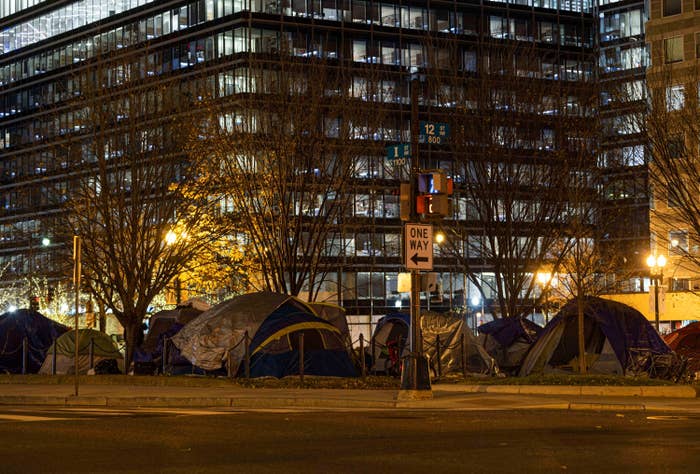
When Jessica Kelly became homeless in Las Vegas in 2020, she carried knives, Tasers, and pepper spray. Trying to sleep often meant climbing on top of jungle gyms at the park, “elevated up, so would nobody come in and try to…you know?” she told BuzzFeed News. “We never knew what was going to happen.” Many nights, it was hard to sleep.
Kelly’s fears were chillingly exemplified this month after five people experiencing homelessness in New York and Washington, DC, were shot, two fatally. The shootings are resurfacing daily atrocities faced by unhoused people around the country.
“Homelessness is a very dangerous undertaking,” especially for women, older adults, people with severe mental health issues, and people with substance abuse issues, who “are more likely to be attacked or victimized on the street,” said Donald Whitehead, executive director for the National Coalition for the Homeless (NCH), who himself was previously homeless. “These kinds of activities are happening all the time.”
There were at least 1,852 reported violent attacks on unhoused people by suspects who were not homeless from 1999 to 2019, including “murder, beatings, rape, and mutilations,” according to the NCH, which aggregates such data — many more go unreported. The incidents included 515 fatal attacks, including victims being shot, stabbed, set on fire, and drowned. The group is now revising how it collects this data to also include attacks in which the perpetrator did not clearly express bias based on the victim’s housing status, as well as crimes where both the attacker and victim were homeless, to more accurately reflect the overall “level of violence that people face on the streets of this country,” Whitehead said.
The suspect in the latest series of shootings, identified as Gerald Brevard III, can be seen in video footage of one of the incidents obtained by the New York Post pacing back and forth next to an unhoused man in a sleeping bag on the sidewalk. He nudges the man with his foot multiple times while he looks around, as if to check if he is awake and if anyone is watching, before pulling out a gun, shooting him, and running away. Brevard himself had previously been homeless and has a history of mental illness, his relatives told the New York Times.
🚨WANTED for SHOOTING: Today, between 4:36 am & 6:00 am, in the confines of the @NYPD1pct and @NYPD5pct, the suspect approached two homeless individuals on the street and shot both of them, killing one individual. NYPD executives will provide an update live at 9:30 PM
In a joint statement, New York Mayor Eric Adams and DC Mayor Muriel Bowser said, “The rise in gun violence has shaken all of us and it is particularly horrible to know that someone is out there deliberately doing harm to an already vulnerable population.”
The risk of homelessness is growing as eviction moratoriums enacted during the pandemic expire, rental assistance funds run out, and housing prices around the country reach record highs. If the government doesn’t provide long-term rent subsidies and emergency rental assistance, “We're gonna have a real big crisis across the state,” said Jacquelyn Simone, policy director for the Coalition for the Homeless in New York. In January 2020, 580,466 people experienced homelessness across the United States, federal data shows, up 2.2% from 2019; data from 2021 is incomplete, as many programs did not do full counts of unsheltered people (who live in parks, streets, and vehicles) due to the pandemic.
In response to pervasive bias against people experiencing homelessness, efforts have been made to revise federal hate crime laws to include homeless status as a protected class — alongside race, color, national origin, ethnicity, gender, disability, and sexual orientation — but those proposals have not been approved. Various protections have been extended to people who are unhoused at the state and local level, according to the NCH, such as including them in local hate crime laws or criminalizing harassment of people without homes.
While people who are unhoused have been behind a number of attacks recently, including the death of Michelle Alyssa Go, who was pushed on the subway, in fact, “homeless New Yorkers are far more likely to be victims of violent crime than perpetrators,” Simone said in a statement. In the 12 months ending in June 2021, city data shows 22 people experiencing homelessness in New York City were killed in homicides.

